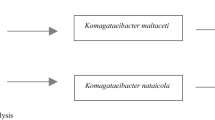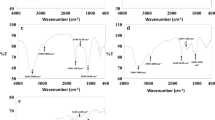Abstract
Cellulose producing bacteria were isolated from fruit samples and kombucha tea (a fermented beverage) using CuSO4 solution in modified Watanabe and Yamanaka medium to inhibit yeasts and molds. Six bacterial strains showing cellulose production were isolated and identified by 16S rRNA gene sequencing as Gluconacetobacter xylinus strain DFBT, Ga. xylinus strain dfr-1, Gluconobacter oxydans strain dfr-2, G. oxydans strain dfr-3, Acetobacter orientalis strain dfr-4, and Gluconacetobacter intermedius strain dfr-5. All the cellulose-producing bacteria were checked for the cellulose yield. A potent cellulose-producing bacterium, i.e., Ga. xylinus strain DFBT based on yield (cellulose yield 5.6 g/L) was selected for further studies. Cellulose was also produced in non- conventional media such as pineapple juice medium and hydrolysed corn starch medium. A very high yield of 9.1 g/L cellulose was obtained in pineapple juice medium. Fourier transform infrared spectrometer (FT-IR) analysis of the bacterial cellulose showed the characteristic peaks. Soft cellulose with a very high water holding capacity was produced using limited aeration. Scanning electron microscopy (SEM) was used to analyze the surface characteristics of normal bacterial cellulose and soft cellulose. The structural analysis of the polymer was performed using 13C solid-state nuclear magnetic resonance (NMR). More interfibrillar space was observed in the case of soft cellulose as compared to normal cellulose. This soft cellulose can find potential applications in the food industry as it can be swallowed easily without chewing.






Similar content being viewed by others
References
El-Saied, H., Basta, A. H., & Gobran, R. H. (2004). Research progress in friendly environmental technology for the production of cellulose products (bacterial cellulose and its application). Polymer-Plastics Technology and Engineering, 43, 797–820.
Wan, W. K., Hutter, J. L., Millon, L., & Guhados, G. (2006). Bacterial cellulose and its nanocomposites for biomedical applications. ACS Symposium Series, 938, 221–241.
Barud, H. S., Barrios, C., & Regiani, T. (2008). Self supported silver nanoparticles containing bacterial cellulose membranes. Materials Science and Engineering C: Biomimetic and Supramolecular Systems, 28, 515–518.
Borzani, W., & Desouza, S. J. (1995). Mechanism of the film thickness increasing during the bacterial production of cellulose on non-agitated liquid-media. Biotechnology Letters, 17(11), 1271–1272.
Czaja, W., Romanovicz, D., & Brown, R. M., Jr. (2004). Structural investigations of microbial cellulose produced in stationary and agitated culture. Cellulose, 11, 403–411.
Watanabe, K., Hori, Y., Tabuchi, M., Morinaga, Y., Yoshinaga, F., Horii, F., Sugiyama, J., & Okano, T. (1994). Structural features of bacterial cellulose vary depending on the cultural conditions (pp. 45–50). Kyoto: Proc. Cellulose Society of Japan.
Klemm, D., Heublein, B., Fink, H. P., & Bohn, A. (2005). Cellulose: fascinating biopolymer and sustainable raw material. Angewandte Chemie International Edition, 44, 3358–3393.
Bajaj, I., Chawla, P., Singhal, R., & Survase, S. (2009). Microbial cellulose: fermentative production and applications. Microbial cellulose: fermentative production and applications. Food Technology and Biotechnology, 47(2), 107–124.
Chau, F., Yang, P., Yu, C.-M., & Yen, G.-C. (2008). Investigation on the lipid- and cholesterol-lowering abilities of biocellulose. Journal of Agricultural and Food Chemistry, 56(6), 2291–2295.
Ren, G., Hu, D., Cheng, E. W., Vargas-Reus, M. A., Reip, P., & Allaker, R. P. (2009). Characterisation of copper oxide nanoparticles for antimicrobial applications. International Journal of Antimicrobial Agents, 33(6), 587–590.
Ramyadevi, J., Jeyasubramanian, K., Marikani, A., Rajakumar, G., & Rahuman, A. A. (2012). Synthesis and antimicrobial activity of copper nanoparticles. Materials Letters, 71, 114–116.
Rathore, P., Hegde, A., Ginjupalli, K., & Upadhya, P. N. (2009). Evaluation of antifungal activity of additives to resilient liners: an in vitro pilot study. Artificial Organs, 23(1), 6–9.
Ramana, K. V., Tomar, A., & Singh, L. (2000). Effect of various carbon and nitrogen sources on cellulose synthesis by Acetobacter xylinum. World Journal of Microbiology and Biotechnology, 16(3), 245–248.
Muthukumarasamy, R., Revathi, G., Seshadri, S., & Lakshminarasimhan, C. (2002). Gluconacetobacter diazotrophicus (syn. Acetobacter diazotrophicus), a promising diazotrophic endophyte in tropics. Current Science, 83(2), 137–145.
Compant, S., Mitter, B., Colli-Mull, J. G., Gangl, H., & Sessitsch, A. (2011). Endophytes of grapevine flowers, berries, and seeds: identification of cultivable bacteria, comparison with other plant parts, and visualization of niches of colonization. Microbial Ecology, 62(1), 188–197.
Krishnan, P., Bhat, R., Kush, A., & Ravikumar, P. (2012). Isolation and functional characterization of bacterial endophytes from Carica papaya fruits. Journal of Applied Microbiology, 113(2), 308–317.
Jesus, E. G., Andres, R. M., & Magno, E. T. (1971). A study on the isolation and screening of microorganisms for production of diverse textured nata. The Philippine Journal of Science, 100, 41–52.
Jahan, F., Kumar, V., Rawat, G., & Saxena, R. K. (2012). Production of microbial cellulose by a bacterium isolated from fruit. Applied Biochemistry and Biotechnology, 167(5), 1157–1171.
Halib, N., Iqbal, M. C., Amin, M., & Ahmad, I. (2012). Physicochemical properties and characterization of nata de coco from local food industries as a source of cellulose. Sains Malaysiana, 41(2), 205–211.
Sun, Y., Lin, L., Deng, H., Li, J., He, B., Sun, R., & Ouyang, P. (2008). Structure of bamboo in formic acid. Bioresources, 3(2), 297–331.
Hornung, M., Ludwig, M., Gerrard, A. M., & Schmauder, H. P. (2006). Optimizing the production of bacterial cellulose in surface culture: evaluation of substrate mass transfer influences on the bioreaction (Part 1). Engineering in Life Science, 6(6), 537–545.
Goh, W. H., Rosma, A., Kaur, B., Fazilah, A., Karim, A. A., & Rajeev, B. (2012). Microstructure and physical properties of microbial cellulose produced during fermentation of black tea broth (Kombucha) II. International Food Research Journal, 19, 153–158.
Watanabe, K., Tabuchi, M., Morinaga, Y., & Yoshinaga, F. (1998). Structural features and properties of bacterial cellulose produced in agitated culture. Cellulose, 5, 187–200.
Kai, A., & Ping, X. U. (1994). C.p./m.a.s. 13C N.M.R. study on microbial cellulose-fluorescent brightener complexes. Polymer, 35, 75–79.
Author information
Authors and Affiliations
Corresponding author
Rights and permissions
About this article
Cite this article
Neera, Ramana, K.V. & Batra, H.V. Occurrence of Cellulose-Producing Gluconacetobacter spp. in Fruit Samples and Kombucha Tea, and Production of the Biopolymer. Appl Biochem Biotechnol 176, 1162–1173 (2015). https://doi.org/10.1007/s12010-015-1637-8
Received:
Accepted:
Published:
Issue Date:
DOI: https://doi.org/10.1007/s12010-015-1637-8




